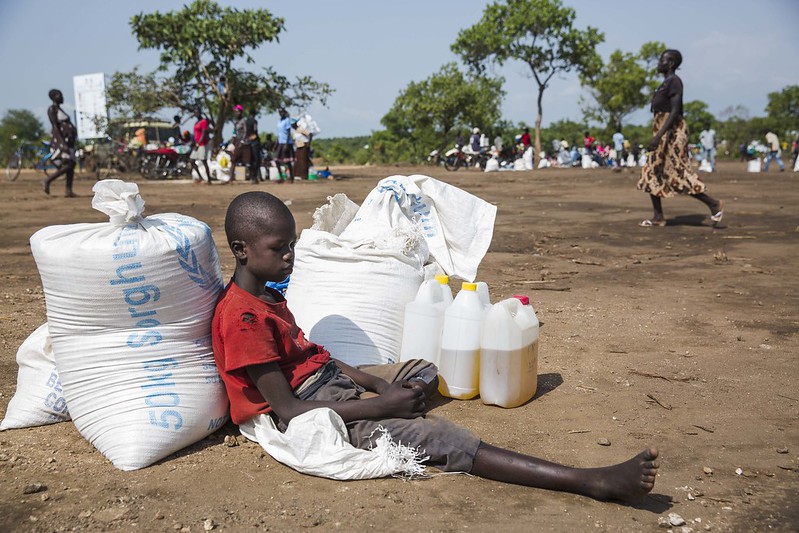Already in the 5th century BC, Sun Tzu documented food being weaponised in war in his book The Art of War. Still today, deliberate restriction of food is used as a tool to weaken or destroy populations. Between 691 and 783 million people are experiencing food insecurity, 85% of which live in armed conflict settings – where aggressors often, from Gaza and Ukraine to Yemen and the Democratic Republic of Congo, intentionally use starvation as a weapon.
Currently, we see the devastating effects on communities in contexts such as Yemen, Syria, Gaza, South Sudan, and Tigray, Ethiopia. All these humanitarian crises include mass starvation and food insecurity, with the use of food as a war strategy recognised by the United Nations Security Council. Food as a weapon of war refers to the intentional manipulation or deprivation of food supplies in conflict situations to weaken or harm populations. It includes blocking access to food, destroying crops, poisoning water supplies, or imposing blockades that result in starvation, malnutrition, or other related harms.
Many think that humanitarian organizations can provide food deliveries and relief. But that is much more difficult than expected. When food gets scarce, any available food becomes much more valuable and thus risky to possess and transport. To secure transport, humanitarian organizations rely on security support, but whom to trust in a complex political context? How can one ensure those most in need receive sufficient relief in time? If one does manage to bring in food relief, local food production loses its value, and related infrastructure gradually dissolves. The community’s resilience gets weakened further, making recovery even more difficult.
Deliberate food restriction destroys communities, but also here, the most vulnerable groups bear the brunt of the consequences. Children die of conflict-related starvation in Gaza every day. Women have been reported to having lost pregnancies due to conflict-related starvation, and those pregnant or breastfeeding are of particular risk, as are their babies. Elderly people are starving to death. For example, speaking about the Great Bengal and Ethiopian famines, Indian economist and Nobel laureate Amartya Sen noted that who starves is a question of entitlement: those with more entitlements can flee or manage with what they have, while those more vulnerable are left to starve. When safe water – that is, safely accessible and clean water – is unavailable, communities are unable to uphold sanitary conditions and diseases start to spread, also those most dangerous for small children, pregnant women, the elderly, and people living with illnesses or disabilities.
Starvation’s social impact goes deeper than physical vulnerability. In many societies, care work, food and water collection are disproportionately shouldered by women and girls, making food used as a weapon of war a strategy that particularly targets them and their mental and physical health. Women and girls in most countries around the world spend hours a day on unpaid care work, which gets exacerbated when children and elderly in one’s family are unwell, and the women and girls themselves are weakened by starvation and hygiene and water-related diseases. Increased food insecurity in conflict adds to women’s high existing vulnerabilities. In some societies, for instance, social norms determine what women can (not) eat and in some, women and girls eat last and least. FAO identified higher food insecurity for women in both The Status of Women in Agrifood Systems and The State of Food Security and Nutrition in the World reports.
The United Nations is actively working to abolish the use of food as a weapon of war through initiatives like UN Security Council Resolution 2417 (2018), which condemns the weaponisation of hunger and calls for accountability. High-level meetings, such as the Global Food Systems Summit (2021) and UN efforts in conflict zones such as the World Food Program (WFP), emphasise protecting food security and strengthening legal frameworks to hold perpetrators responsible.
Since it is so destructive, the use of starvation as a method of warfare is prohibited under international humanitarian law. Article 54 of Protocol I Additional to the Geneva Conventions states: “It is prohibited to attack, destroy, remove or render useless objects indispensable to the survival of the civilian population, such as foodstuffs, crops, livestock, drinking water installations and supplies, and irrigation works.” The International Criminal Court (ICC) recognises starvation as a war crime when it is intentionally directed at civilians. As such, the individuals responsible for the use of food as a strategic weapon of war can be held accountable in front of the ICC, where the ICC has jurisdiction. However, the ICC has no jurisdiction in conflicts like Yemen since the United Arab Emirates has not signed the Rome Statute, the treaty that established the ICC. But even in other crises it is extremely difficult to prove this war crime; therefore, securing prosecutions remains a significant challenge. No one has been prosecuted for starvation as a war crime by the ICC, but potential ICC warrants on Israeli actions in Gaza might set a precedent.
It’s important to remember that starvation as a war tactic is not just a thing of the past; it still plays a significant role in modern warfare. Given its disastrous and long-term consequences, using starvation as a weapon is a war crime. Working towards food security for all thus has a much wider scope and includes diplomacy and advocacy for ending using starvation as a strategy in armed conflict.
